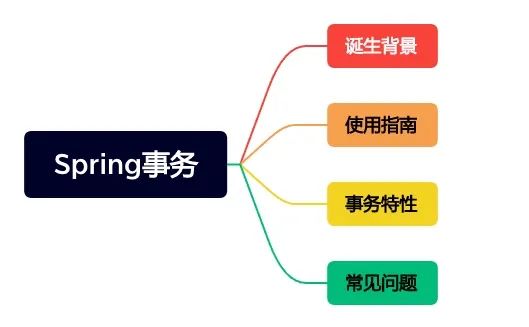大家好,我是树哥。
Spring 事务是复杂一致性业务必备的知识点,掌握好 Spring 事务可以让我们写出更好地代码。这篇文章我们将介绍 Spring 事务的诞生背景,从而让我们可以更清晰地了解 Spring 事务存在的意义。
接着,我们会介绍如何快速使用 Spring 事务。接着,我们会介绍 Spring 事务的一些特性,从而帮助我们更好地使用 Spring 事务。最后,我们会总结一些 Spring 事务常见的问题,避免大家踩坑。

Spring 事务 - 思维导图
诞生背景
当我们聊起事务的时候,我们需要明白「事务」这个词代表着什么。
事务其实是一个并发控制单位,是用户定义的一个操作序列,这些操作要么全部完成,要不全部不完成,是一个不可分割的工作单位。事务有 ACID 四个特性,即:
- Atomicity(原子性):事务中的所有操作,或者全部完成,或者全部不完成,不会结束在中间某个环节。
- 一致性(Consistency):在事务开始之前和事务结束以后,数据库的完整性没有被破坏。
- 事务隔离(Isolation):多个事务之间是独立的,不相互影响的。
- 持久性(Durability):事务处理结束后,对数据的修改就是永久的,即便系统故障也不会丢失。
而我们说的 Spring 事务,其实是事务在 Spring 中的实现。
明白了什么是事务之后,我们来聊聊:为什么要有 Spring 事务?
为了解释清楚这个问题,我们举个简单的例子:银行里树哥要给小黑转 1000 块钱,这时候会有两个必要的操作:
- 将树哥的账户余额减少 1000 元。
- 将小黑的账户余额增加 1000 元。
这两个操作,要么一起都完成,要么都不完成。如果其中某个成功,另外一个失败,那么就会出现严重的问题。而我们要保证这个操作的原子性,就必须通过 Spring 事务来完成,这就是 Spring 事务存在的原因。
如果你深入了解过 MySQL 事务,那么你应该知道:MySQL 默认情况下,对于所有的单条语句都作为一个单独的事务来执行。我们要使用 MySQL 事务的时候,可以通过手动提交事务来控制事务范围。Spring 事务的本质,其实就是通过 Spring AOP 切面技术,在合适的地方开启事务,接着在合适的地方提交事务或回滚事务,从而实现了业务编程层面的事务操作。
使用指南
Spring 事务支持两种使用方式,分别是:声明式事务(注解方式)、编程式事务(代码方式)。一般来说,我们使用声明式事务比较多,这里我们就演示声明式事务的使用方法。
项目准备
为了较好地进行讲解,我们需要搭建一个具备数据库 CURD 功能的项目,并创建 tablea 和 tableb 两张表。
首先,创建 tablea 和 tableb 两张表,两张表都只有 id 和 name 两列,建表语句如下图所示。
CREATE TABLE `tablea` (
`id` int NOT NULL AUTO_INCREMENT,
`name` varchar(45) DEFAULT NULL,
PRIMARY KEY (`id`)
) ENGINE=InnoDB AUTO_INCREMENT=1;
CREATE TABLE `tableb` (
`id` int NOT NULL AUTO_INCREMENT,
`name` varchar(45) DEFAULT NULL,
PRIMARY KEY (`id`)
) ENGINE=InnoDB AUTO_INCREMENT=1;
接着,创建一个 SpringBoot 项目,随后加入 MyBatis 及 MySQL 的 POM 依赖。
<dependency>
<groupId>mysql</groupId>
<artifactId>mysql-connector-java</artifactId>
</dependency>
<dependency>
<groupId>org.mybatis.spring.boot</groupId>
<artifactId>mybatis-spring-boot-starter</artifactId>
<version>2.1.0</version>
</dependency>
最后,我们创建对应的 controller 接口、service 接口、mapper 接口,代码如下所示。
创建 controller 接口:
@SpringBootApplication
@RestController
@RequestMapping("/api")
public class SpringTransactionController {
@Autowired
private TransactionServiceA transactionServiceA;
@RequestMapping("/spring-transaction")
public String testTransaction() {
transactionServiceA.methodA();
return "SUCCESS";
}
}
创建 TableService 接口。
public interface TableService {
void insertTableA(TableEntity tableEntity);
void insertTableB(TableEntity tableEntity);
}
创建 Service 接口实现类 TransactionServiceA 类,在 methodA () 方法中先往 tablea 表格插入一条数据,随后会调用 TransactionServiceB 服务的 methodB () 方法。
@Service
public class TransactionServiceA {
@Autowired
private TableService tableService;
@Autowired
private TransactionServiceB transactionServiceB;
public void methodA(){
System.out.println("methodA");
tableService.insertTableA(new TableEntity());
transactionServiceB.methodB();
}
}
创建 TransactionServiceB 类实现,在 methodB () 方法中往 tableb 表格插入一条数据。
@Service
public class TransactionServiceB {
@Autowired
private TableService tableService;
public void methodB(){
System.out.println("methodB");
tableService.insertTableB(new TableEntity());
}
}
创建 Mapper 接口方法:
@Mapper
public interface TableMapper {
@Insert("INSERT INTO tablea(id, name) " +
"VALUES(#{id}, #{name})")
@Options(useGeneratedKeys = true, keyProperty = "id")
void insertTableA(TableEntity tableEntity);
@Insert("INSERT INTO tableb(id, name) " +
"VALUES(#{id}, #{name})")
@Options(useGeneratedKeys = true, keyProperty = "id")
void insertTableB(TableEntity tableEntity);
}
数据库表对应的 TableEntity:
@Data
public class TableEntity {
private static final long serialVersionUID = 1L;
private Long id;
private String name;
public TableEntity() {
}
public TableEntity(String name) {
this.name = name;
}
}
最后,我们在配置文件中配置好数据库地址:
spring:
datasource:
url: jdbc:mysql://localhost:3306/test?serverTimezone=UTC&useUnicode=true&characterEncoding=utf-8&useSSL=true
username: root
password: root
driver-class-name: com.mysql.cj.jdbc.Driver
# MyBatis 配置
mybatis:
type-aliases-package: tech.shuyi.javacodechip.spring_transaction.model
configuration:
map-underscore-to-camel-case: true
最后,我们运行 SpringBoot 项目。通过浏览器访问地址:localhost:8080/api/spring-transaction,正常的话应该是接口请求成功。

查看数据库表,会看到 tablea 和 tableb 都插入了一条数据。
到这里,我们用于测试 Spring 事务的 Demo 就准备完毕了!
快速入门
使用声明式事务的方法很简单,其实就是在 Service 层对应方法上配置 @Transaction 注解即可。
假设我们的业务需求是:往 tablea 和 tableb 插入的数据,要么都完成,要么都不完成。
这时候,我们应该怎么操作呢?
首先,我们需要在 TransactionServiceA 类的 methodA () 方法上配置 @Transaction 注解,同时也在 TransactionServiceB 类的 methodB () 方法上配置 @Transaction 注解。修改之后的 TransactionServiceA 和 TransactionServiceB 代码如下所示。
// TransactionServiceA
@Transactional
public void methodA(){
System.out.println("methodA");
tableService.insertTableA(new TableEntity());
transactionServiceB.methodB();
}
// TransactionServiceB
@Transactional
public void methodB(){
System.out.println("methodB");
tableService.insertTableB(new TableEntity());
throw new RuntimeException();
}
可以看到,我们在 methodB () 中模拟了业务异常,我们看看是否 tablea 和 tableb 都没有插入数据。
修改之后重新启动项目,此时我们继续访问地址:localhost:8080/api/spring-transaction,我们会发现执行错误,并且控制台也报错了。


这时候我们查看数据库,会发现 tablea 和 tableb 都没有插入数据。这说明事务起作用了。
事务传播类型
事务传播类型,指的是事务与事务之间的交互策略。例如:在事务方法 A 中调用事务方法 B,当事务方法 B 失败回滚时,事务方法 A 应该如何操作?这就是事务传播类型。Spring 事务中定义了 7 种事务传播类型,分别是:REQUIRED、SUPPORTS、MANDATORY、REQUIRES_NEW、NOT_SUPPORTED、NEVER、NESTED。其中最常用的只有 3 种,即:REQUIRED、REQUIRES_NEW、NESTED。
针对事务传播类型,我们要弄明白的是 4 个点:
- 子事务与父事务的关系,是否会启动一个新的事务?
- 子事务异常时,父事务是否会回滚?
- 父事务异常时,子事务是否会回滚?
- 父事务捕捉异常后,父事务是否还会回滚?
REQUIRED
REQUIRED 是 Spring 默认的事务传播类型,该传播类型的特点是:当前方法存在事务时,子方法加入该事务。此时父子方法共用一个事务,无论父子方法哪个发生异常回滚,整个事务都回滚。即使父方法捕捉了异常,也是会回滚。而当前方法不存在事务时,子方法新建一个事务。 为了验证 REQUIRED 事务传播类型的特点,我们来做几个测试。
还是上面 methodA 和 methodB 的例子。当 methodA 不开启事务,methodB 开启事务,这时候 methodB 就是独立的事务,而 methodA 并不在事务之中。因此当 methodB 发生异常回滚时,methodA 中的内容就不会被回滚。用如下的代码就可以验证我们所说的。
public void methodA(){
System.out.println("methodA");
tableService.insertTableA(new TableEntity());
transactionServiceB.methodB();
}
@Transactional
public void methodB(){
System.out.println("methodB");
tableService.insertTableB(new TableEntity());
throw new RuntimeException();
}
最终的结果是:tablea 插入了数据,tableb 没有插入数据,符合了我们的猜想。
当 methodA 开启事务,methodB 也开启事务。按照我们的结论,此时 methodB 会加入 methodA 的事务。此时,我们验证当父子事务分别回滚时,另外一个事务是否会回滚。
我们先验证第一个:当父方法事务回滚时,子方法事务是否会回滚?
@Transactional
public void methodA(){
tableService.insertTableA(new TableEntity());
transactionServiceB.methodB();
throw new RuntimeException();
}
@Transactional
public void methodB(){
tableService.insertTableB(new TableEntity());
}
结果是:talbea 和 tableb 都没有插入数据,即:父事务回滚时,子事务也回滚了。
我们继续验证第二个:当子方法事务回滚时,父方法事务是否会回滚?
@Transactional
public void methodA(){
tableService.insertTableA(new TableEntity());
transactionServiceB.methodB();
}
@Transactional
public void methodB(){
tableService.insertTableB(new TableEntity());
throw new RuntimeException();
}
结果是:talbea 和 tableb 都没有插入数据,即:子事务回滚时,父事务也回滚了。
我们继续验证第三个:当字方法事务回滚时,父方法捕捉了异常,父方法事务是否会回滚?
@Transactional
public void methodA() {
tableService.insertTableA(new TableEntity());
try {
transactionServiceB.methodB();
} catch (Exception e) {
System.out.println("methodb occur exp.");
}
}
@Transactional
public void methodB() {
tableService.insertTableB(new TableEntity());
throw new RuntimeException();
}
结果是:talbea 和 tableb 都没有插入数据,即:子事务回滚时,父事务也回滚了。所以说,这也进一步验证了我们之前所说的:REQUIRED 传播类型,它是父子方法共用同一个事务的。
REQUIRES_NEW
REQUIRES_NEW 也是常用的一个传播类型,该传播类型的特点是:无论当前方法是否存在事务,子方法都新建一个事务。此时父子方法的事务时独立的,它们都不会相互影响。但父方法需要注意子方法抛出的异常,避免因子方法抛出异常,而导致父方法回滚。 为了验证 REQUIRES_NEW 事务传播类型的特点,我们来做几个测试。
首先,我们来验证一下:当父方法事务发生异常时,子方法事务是否会回滚?
@Transactional
public void methodA(){
tableService.insertTableA(new TableEntity());
transactionServiceB.methodB();
throw new RuntimeException();
}
@Transactional(propagation = Propagation.REQUIRES_NEW)
public void methodB(){
tableService.insertTableB(new TableEntity());
}
结果是:tablea 没有插入数据,tableb 插入了数据,即:父方法事务回滚了,但子方法事务没回滚。这可以证明父子方法的事务是独立的,不相互影响。
下面,我们来看看:当子方法事务发生异常时,父方法事务是否会回滚?
@Transactional
public void methodA(){
tableService.insertTableA(new TableEntity());
transactionServiceB.methodB();
}
@Transactional(propagation = Propagation.REQUIRES_NEW)
public void methodB(){
tableService.insertTableB(new TableEntity());
throw new RuntimeException();
}
结果是:tablea 没有插入了数据,tableb 没有插入数据。
从这个结果来看,貌似是子方法事务回滚,导致父方法事务也回滚了。但我们不是说父子事务都是独立的,不会相互影响么?怎么结果与此相反呢?
其实是因为子方法抛出了异常,而父方法并没有做异常捕捉,此时父方法同时也抛出异常了,于是 Spring 就会将父方法事务也回滚了。如果我们在父方法中捕捉异常,那么父方法的事务就不会回滚了,修改之后的代码如下所示。
@Transactional
public void methodA(){
tableService.insertTableA(new TableEntity());
// 捕捉异常
try {
transactionServiceB.methodB();
} catch (Exception e) {
e.printStackTrace();
}
}
@Transactional(propagation = Propagation.REQUIRES_NEW)
public void methodB(){
tableService.insertTableB(new TableEntity());
throw new RuntimeException();
}
结果是:tablea 插入了数据,tableb 没有插入数据。这正符合我们刚刚所说的:父子事务是独立的,并不会相互影响。
这其实就是我们上面所说的:父方法需要注意子方法抛出的异常,避免因子方法抛出异常,而导致父方法回滚。因为如果执行过程中发生 RuntimeException 异常和 Error 的话,那么 Spring 事务是会自动回滚的。
NESTED
NESTED 也是常用的一个传播类型,该方法的特性与 REQUIRED 非常相似,其特性是:当前方法存在事务时,子方法加入在嵌套事务执行。当父方法事务回滚时,子方法事务也跟着回滚。当子方法事务发送回滚时,父事务是否回滚取决于是否捕捉了异常。如果捕捉了异常,那么就不回滚,否则回滚。
可以看到 NESTED 与 REQUIRED 的区别在于:父方法与子方法对于共用事务的描述是不一样的,REQUIRED 说的是共用同一个事务,而 NESTED 说的是在嵌套事务执行。这一个区别的具体体现是:在子方法事务发生异常回滚时,父方法有着不同的反应动作。
对于 REQUIRED 来说,无论父子方法哪个发生异常,全都会回滚。而 REQUIRED 则是:父方法发生异常回滚时,子方法事务会回滚。而子方法事务发送回滚时,父事务是否回滚取决于是否捕捉了异常。
为了验证 NESTED 事务传播类型的特点,我们来做几个测试。
首先,我们来验证一下:当父方法事务发生异常时,子方法事务是否会回滚?
@Transactional
public void methodA() {
tableService.insertTableA(new TableEntity());
transactionServiceB.methodB();
throw new RuntimeException();
}
@Transactional(propagation = Propagation.NESTED)
public void methodB() {
tableService.insertTableB(new TableEntity());
}
结果是:tablea 和 tableb 都没有插入数据,即:父子方法事务都回滚了。这说明父方法发送异常时,子方法事务会回滚。
接着,我们继续验证一下:当子方法事务发生异常时,如果父方法没有捕捉异常,父方法事务是否会回滚?
@Transactional
public void methodA() {
tableService.insertTableA(new TableEntity());
transactionServiceB.methodB();
}
@Transactional(propagation = Propagation.NESTED)
public void methodB() {
tableService.insertTableB(new TableEntity());
throw new RuntimeException();
}
结果是:tablea 和 tableb 都没有插入数据,即:父子方法事务都回滚了。这说明子方法发送异常回滚时,如果父方法没有捕捉异常,那么父方法事务也会回滚。
最后,我们验证一下:当子方法事务发生异常时,如果父方法捕捉了异常,父方法事务是否会回滚?
@Transactional
public void methodA() {
tableService.insertTableA(new TableEntity());
try {
transactionServiceB.methodB();
} catch (Exception e) {
}
}
@Transactional(propagation = Propagation.NESTED)
public void methodB() {
tableService.insertTableB(new TableEntity());
throw new RuntimeException();
}
结果是:tablea 插入了数据,tableb 没有插入数据,即:父方法事务没有回滚,子方法事务回滚了。这说明子方法发送异常回滚时,如果父方法捕捉了异常,那么父方法事务就不会回滚。
看到这里,相信大家已经对 REQUIRED、REQUIRES_NEW 和 NESTED 这三个传播类型有了深入的理解了。最后,让我们来总结一下:
事务传播类型 | 特性 |
REQUIRED | 当前方法存在事务时,子方法加入该事务。此时父子方法共用一个事务,无论父子方法哪个发生异常回滚,整个事务都回滚。即使父方法捕捉了异常,也是会回滚。而当前方法不存在事务时,子方法新建一个事务。 |
REQUIRES_NEW | 无论当前方法是否存在事务,子方法都新建一个事务。此时父子方法的事务时独立的,它们都不会相互影响。但父方法需要注意子方法抛出的异常,避免因子方法抛出异常,而导致父方法回滚。 |
NESTED | 当前方法存在事务时,子方法加入在嵌套事务执行。当父方法事务回滚时,子方法事务也跟着回滚。当子方法事务发送回滚时,父事务是否回滚取决于是否捕捉了异常。如果捕捉了异常,那么就不回滚,否则回滚。 |
应该怎么用?
看完了事务的传播类型,我们对 Spring 事务又有了深刻的理解。
看到这里,你应该也明白:使用事务,不再是简单地使用 @Transaction 注解就可以,还需要根据业务场景,选择合适的传播类型。那么我们再升华一下使用 Spring 事务的方法论。一般来说,使用 Spring 事务的步骤为:
根据业务场景,分析要达成的事务效果,确定使用的事务传播类型。
在 Service 层使用 @Transaction 注解,配置对应的 propogation 属性。
下次遇到要使用事务的情况,记得按照这样的步骤去做哦~
Spring 事务失效
什么时候 Spring 事务会失效?
若同一类中的其他没有 @Transactional 注解的方法内部调用有 @Transactional 注解的方法,有 @Transactional 注解的方法的事务会失效。
这是由于 Spring AOP 代理的原因造成的,因为只有当 @Transactional 注解的方法在类以外被调用的时候,Spring 事务管理才生效。
另外,如果直接调用,不通过对象调用,也是会失效的。因为 Spring 事务是通过 AOP 实现的。
@Transactional 注解只有作用到 public 方法上事务才生效。
被 @Transactional 注解的方法所在的类必须被 Spring 管理。
底层使用的数据库必须支持事务机制,否则不生效。
彩蛋
Spring 事务执行过程中,如果抛出非 RuntimeException 和非 Error 错误的其他异常,那么是不会回滚的哦。例如下面的代码执行后,tablea 和 tableb 两个表格,都会插入一条数据。
@Transactional
public void methodA() throws Exception {
tableService.insertTableA(new TableEntity());
transactionServiceB.methodB();
}
@Transactional
public void methodB() throws Exception {
tableService.insertTableB(new TableEntity());
// 非 RuntimeException
throw new Exception();
}
参考资料
- 咱们从头到尾说一次 Spring 事务管理(器) - SegmentFault 思否
- 【技术干货】Spring 事务原理一探 - 知乎
- Spring 事务详解 | JavaGuide
- 事务之六:spring 嵌套事务 - duanxz - 博客园
- 例子很详细,不错!VIP!NESTED 区别!spring 事务传播行为详解 - 双间 - 博客园
- Spring Boot 实战 —— MyBatis(注解版)使用方法 | Michael 翔
- 记一次事务的坑 Transaction rolled back because it has been marked as rollback-only - 云扬四海








































